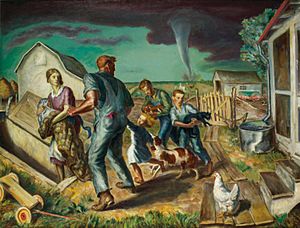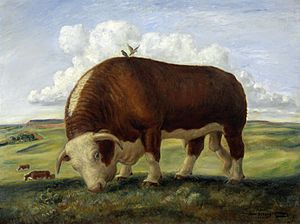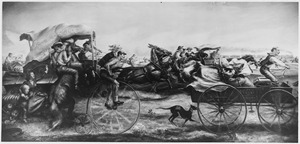John Steuart Curry facts for kids
Quick facts for kids
John Steuart Curry
|
|
|---|---|
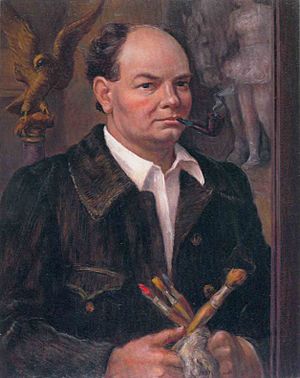
Self-portrait, 1937
|
|
| Born |
John Steuart Curry
November 14, 1897 Dunavant, Kansas, US
|
| Died | August 29, 1946 (aged 48) |
| Known for | Painting |
|
Notable work
|
Baptism in Kansas (1928), Tornado over Kansas (1929), Tragic Prelude (1937–1942) |
| Movement | Regionalism |
John Steuart Curry (born November 14, 1897 – died August 29, 1946) was an American painter. He was famous for his paintings that showed everyday life in his home state, Kansas. He was one of the three most important painters of a style called Regionalism in the early 1900s. The other two were Thomas Hart Benton and Grant Wood.
Curry created many different types of art, including paintings, pictures for books, and posters. Even though he was Kansas's most well-known painter, many people in Kansas did not like his art. They felt he did not show the state in a good way. His paintings often showed farm life, animals, tornadoes, prairie fires, and the violent "Bleeding Kansas" time. This period featured John Brown, who was seen by some as a traitor. Kansans did not want these subjects to represent their state.
Curry was asked to paint large murals for the Kansas State Capitol building. He finished two of them: Kansas Pastoral and his most famous work, Tragic Prelude. He believed Tragic Prelude was his best work. However, people in Kansas reacted so negatively that the state government passed a rule to stop his works from being hung in the Capitol. Because of this, Curry did not sign the murals, and they were not displayed during his lifetime. He left Kansas feeling very upset. His plans for eight smaller murals in the Capitol never happened.
Curry's paintings showed a lot of movement. He used free brushstrokes and energetic shapes to create his style. He could control his brushstrokes to show strong feelings like fear and sadness in his art. Other Regionalist painters, who also painted action, influenced his style.
Contents
Biography of John Steuart Curry
Curry was born on a farm in Dunavant, Kansas, on November 14, 1897. He was the oldest of five children. His parents, Thomas Smith Curry and Margaret Steuart Curry, both went to college and had even traveled to Europe. Growing up, Curry helped care for animals on the farm and was good at sports. His childhood home had many copies of paintings by Peter Paul Rubens and Gustave Doré. These artists greatly influenced Curry's own painting style.
His family was very religious, like most people in Dunavant. Curry was encouraged to paint the animals around the farm. When he was twelve, he had his first art lesson. In 1916, he started at the Kansas City Art Institute. After only a month, he moved to the Art Institute of Chicago, where he studied for two years. In 1918, he went to Geneva College in Beaver Falls, Pennsylvania.
After college, Curry worked as an illustrator from 1921 to 1926. He drew pictures for several magazines, including Boys' Life, St. Nicholas Magazine, The Country Gentleman, and The Saturday Evening Post.
In 1926, Curry spent a year in Paris, France. He studied the works of artists like Gustave Courbet and Honoré Daumier. He also learned color techniques from Titian and Rubens. When he returned to the United States, he lived in New York City and married Clara Derrick. Soon after, they moved to an artists' community in Westport, Connecticut. Clara died in June 1932. For the next two years, Curry focused on painting in his studio. He briefly traveled with the Ringling Brothers Circus and painted The Flying Cadonas during that time. He married Kathleen Gould in 1934.
In 1936, Curry became the first artist-in-residence at the College of Agriculture at the University of Wisconsin. This meant he was an artist who lived and worked at the university. They built him a small studio. He did not have to teach classes or have specific duties. He was free to travel around Wisconsin and encourage art in farming communities. He also gave art lessons to students. This experience made Curry interested in protecting nature. He became worried about the serious soil erosion and dust bowl storms in Kansas caused by farming.
In the same year, he was asked to paint a mural for the Department of Justice Building and Main Interior Building in Washington. In 1937, he became an Associate Member of the National Academy of Design, and a full member in 1943. This was followed by a big project: painting murals about Kansas for the Kansas State Capitol in Topeka.
Curry continued to work at the University of Wisconsin until he died of a heart attack in Madison in 1946. He was 48 years old.
Understanding Regionalism in Art
John Steuart Curry was one of the three most important painters of American Regionalism. The other two were Thomas Hart Benton and Grant Wood. All three artists were from the Midwest of the United States. Wood was from Iowa, Benton from Missouri, and Curry from Kansas. Their art showed a look back at rural life in the American heartland.
Regionalism was a way for artists to react against the idea of everything being the same. During the industrial revolution, factories made many goods, which made them cheaper. But this also meant less variety and local creativity. The Wall Street Crash of 1929 and the Great Depression showed problems with the economy. Regionalist art showed strong pictures of independent, rural life in wide-open spaces. It offered a different idea of American life.
Unlike Wood and Benton, Curry did not live in Kansas as an adult. Curry knew that rural life in Kansas had its challenges. These included tornadoes, prairie fires, dust storms, insect problems, and floods. His paintings showed these difficult parts of life. Because of this, some Kansans were unsure if he should be called Kansas's greatest painter. In fact, his paintings did not sell well in Kansas.
The University of Wisconsin hired him in 1936 as an artist-in-residence. No university in Kansas would offer him such a job. At Wisconsin, Curry became interested in protecting the environment. He planned to show the tragedy of soil erosion in one of his murals for the Kansas Capitol. He wanted it to be a "warning" to Kansas farmers about the environmental damage they had caused. He was surprised when these plans made many local people upset.
John Steuart Curry and Wisconsin
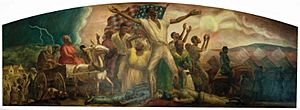
John Steuart Curry was seen as a great Kansas painter during his time. He openly said he wanted to paint murals for Kansas. However, his connection with Kansas was complicated. He lived in Connecticut and turned down many suggestions to move back to Kansas. Instead, he moved to Wisconsin in 1936 when the University of Wisconsin offered him a job as an artist-in-residence, which no Kansas school would do. He stayed there until he died in 1946.
While in Wisconsin, he finished a large mural in 1942 called Freeing of the Slaves. It was about the Emancipation Proclamation. This painting was first planned for the new U.S. Department of Justice Building in 1936. But the early drawings were rejected by government officials. They worried about "serious difficulties" because of the painting's themes about race. Curry painted two other murals in that building: Movement of the Population Westward and Law versus Mob Rule. However, the design for Freeing of the Slaves caught the eye of Lloyd K. Garrison, the dean of the Wisconsin Law School. Garrison had the mural placed in the Reading Room of the new Law School library.
John Steuart Curry and Kansas
In his many works about Kansas, Curry wanted to show his "personal view" of Kansas history. He said, "I want to picture what I feel about my native state." To prepare for his biggest project, the Kansas Capitol murals, he spent days studying Kansas history. He visited the Kansas Historical Society and the Topeka Public Library. He said he wanted to "wreak good" upon Kansas.
Curry painted Kansas exactly as he saw it, including its problems. His planned paintings for the first floor of the Kansas Capitol, which were only sketches, included one about protecting nature and soil erosion. Curry shared the view of professors at the College of Agriculture. They believed that Kansas farmers' poor soil management caused the erosion and dust storms of the 1930s.
Many Kansans were not happy about this. They did not want soil erosion or the supposed mistakes of Kansas farmers shown in their Capitol. Also, John Brown was seen by many as a convicted traitor and a strange person. The opposition grew so strong that Curry gave up his big Kansas Capitol project in frustration. He refused to sign the two murals he did finish. He said they were meant to be seen as part of a larger group. They were hung in the Capitol after his death.
Baptism in Kansas
In August 1928, Curry painted Baptism in Kansas. This painting was shown at the Corcoran Gallery in Washington, D.C., and became famous almost immediately. The New York Times praised the painting. It also got the attention of Mrs. Gertrude Vanderbilt Whitney. In 1931, Mrs. Vanderbilt Whitney bought the painting for the Whitney Museum of American Art in New York City. This helped establish Curry as a major artist.
Baptism in Kansas showed religious groups holding outdoor baptisms. These popular religious events were a common part of rural life that Curry saw in Kansas. He painted the scene with respect.
Curry's painting was surprising to people in the Eastern United States. They would not have connected a baptism with full immersion or a barnyard setting. But Curry painted what he knew. As Lawrence Shmeckebrier said, Curry "saw this scene as conceived and executed with sincere reverence and understanding of one who had lived it." Curry's religious painting shows an event he observed, rather than making fun of religious beliefs.
Tornado over Kansas
With Mrs. Whitney's support, Curry painted Tornado over Kansas. This painting shows a farmer facing an approaching tornado. He and his wife are helping their family and animals get into a tornado shelter. The painting was shown in 1929, just before the Wall Street Crash in October. It offered city people a romantic idea of humans facing nature. Like many of Curry's works from the 1930s, it showed scenes of work, family, and land. It aimed to show the peace, struggle, and strength that Curry believed were at the heart of American life, especially in Kansas.
Kansas Pastoral
Kansas Pastoral is the first of two murals Curry finished for the Kansas Capitol. It shows an imaginary perfect farm life. The farmer is relaxed, and the farm, its crops, and animals seem to be perfectly ordered. The farm woman no longer needs to do hard physical work and can focus on her home.
Tragic Prelude
Tragic Prelude tells a visual story of Kansas history. It shows the first Europeans, Juan de Padilla and Coronado. Then it shows a plainsman hunting buffalo. Finally, it shows the "Bleeding Kansas" period from 1854 to 1861. During this time, Kansas was the center of national attention. "Old" John Brown, believing he was doing God's work, led anti-slavery settlers. He used violence if needed to fight against efforts to make Kansas a slave state. Kansas's status was not decided until the start of the Civil War. By then, six slave states had left the Union, and Kansas could join as a free state.
Brown's role during "Bleeding Kansas" was not widely remembered outside of Kansas. However, his name was known to anyone who studied American history. Many believed he helped cause the Civil War on purpose. This was especially true after his raid on the federal arsenal in Harpers Ferry, Virginia (now West Virginia). He was quickly found guilty of treason against Virginia, murder, and starting a slave uprising. He was then hanged. "John Brown's Body" became a marching song for Union soldiers.
Tragic Prelude shows John Brown standing in front of soldiers fighting each other. In the background, an approaching tornado and prairie fires suggest the disaster of the Civil War. They also suggest that Brown seemed to be calling for it.
The painting caused a negative reaction. John Brown, who was convicted of treason, was not someone most Kansans were proud of. The "Bleeding Kansas" period itself was also a difficult memory. Adding to the public's worry was Curry's plan to show damaging soil erosion in another mural. This was a very controversial topic in Kansas. The state government could not fire Curry because newspaper editors had raised money from the public to pay him. However, they took back permission for Curry's works to be hung in the Capitol.
This was very upsetting for Curry. He left Kansas in disgust. He refused to sign the two murals he completed. He said they could not be understood alone, but only as part of a larger series. They were hung in the Capitol after his death.
Political Themes in Art
Curry's art generally had traditional political ideas. He believed that art should be for everyone. He did not believe in political messages, especially the Marxist kind that Diego Rivera made popular in the 1930s. Curry avoided controversial subjects that Rivera used. He felt they did not improve the artistic quality of his work. However, Curry did create a few political sketches, but he never made them into larger projects. Instead, he enjoyed watching public events and drawing them.
Curry's few paintings with political themes came from his own experiences. They were not made to display social comments. For example, The Return of Private Davis, finished in 1940, was inspired by something he saw near his home in 1918. A similar sketch was made in France in 1926. This painting is like a baptism ceremony. It shows the sadness of a rural boy from Kansas who died on a faraway battlefield. The painting shows Curry's personal feelings, not a political message. On the other hand, Parade to War shows soldiers leaving for war, not a victim returning.
Besides war scenes, Curry also painted subjects about manhunts and people on the run. These ideas came from his childhood memories. They were also inspired by publicized events in the early 1930s. Curry's painting, The Fugitive, shows a Black man hiding from a mob. It was shown in a 1935 exhibition that supported a national law against lynching. This law never passed. These earlier political works influenced Curry's later mural work in the Department of Justice Building. Above the entrance to the Justice Department library is Curry's painting, Law vs. Mob Rule. It shows a judge protecting a man who has fallen on the courthouse steps from a mob trying to harm him.
Public Reactions and Legacy
Even though Curry's works were popular in the rest of the country, they were not liked in Kansas. People in Kansas felt he was making fun of the worst parts of their state. They thought including outdoor baptisms and tornadoes made people think bad things about Kansas. When these paintings were shown in New York galleries, many Kansans felt insulted. However, the public in New York was fascinated by Curry's paintings. His art was entertaining and easy to understand. It allowed viewers to see a more simple, isolated, and non-commercial version of America.
In 1992, the Kansas Legislature apologized for how they treated Curry. They also bought the drawings related to his murals.
List of Art Works
This is a list of some of Curry's most important works, listed by date.
- Baptism in Kansas, oil on canvas, 1928, Whitney Museum of American Art, New York City.
- The Old Folks (Mother and Father), oil on canvas, 1929, Cincinnati Art Museum, Cincinnati, OH.
- The Roadworkers Camp, oil on canvas, 1929, F.M. Hall Collection, University of Nebraska, Lincoln.
- Storm Over Lake Otsego, oil on canvas, 1929, collection of Mrs. Polly Thayer Starr, Boston, Massachusetts.
- Tornado over Kansas, oil on canvas, 1929, Muskegon Museum of Art, Muskegon, Michigan.
- Hogs Killing a Snake, oil on canvas, c.1930, Art Institute of Chicago.
- The Medicine Man, oil on canvas, 1931, collection of William Benton, Chicago, Illinois.
- Spring Shower, oil on canvas, 1931, Metropolitan Museum of Art, New York City.
- The Flying Cadonas, oil and tempera on panel, 1932, Whitney Museum of American Art, New York City.
- The Runaway, oil on canvas, 1932, collection of Bryn Mawr College, Bryn Mawr, Pennsylvania.
- The Line Storm, oil and tempera on panel, 1934, collection of Sidney Howard, New York.
- Corn, oil on canvas, 1935, Wichita Art Museum, Wichita, Kansas.
- Ajax, oil on canvas, 1936–37, Smithsonian American Art Museum, Washington, D.C.
- The Oklahoma Land Rush, April 22, 1889, commissioned 1937, installed 1939
- Tragic Prelude, 1937–1942, Kansas State Capitol
- Madison Landscape, oil and tempera on canvas, 1941, Madison Museum of Contemporary Art, Madison, WI
Exhibitions of Curry's Art
Here are some of the art shows where John Steuart Curry's work has been displayed:
- "A Celebration of Rural America," September 9 – October 28, 2007, Danville Museum of Fine Arts and History, Danville, Virginia.
- "Collective Images: the sketchbooks of John Steuart Curry," February 23 – May 5, 2002, Worcester Art Museum, Worcester, Massachusetts.
- "Illusions of Eden: Visions of the American Heartland," February 18 – April 30, 2000, Columbus Museum of Art, Columbus, Ohio.
- "The American Century: Art & Culture 1900–2000," April 23, 1999, Whitney Museum of American Art, New York, New York.
- "John Steuart Curry: Inventing the Middle West," June 13 – August 30, 1998, M. H. de Young Memorial Museum, San Francisco, California.
Archived Materials
The Kansas Historical Society has Curry's early sketches for the State Capitol murals.
See also
 In Spanish: John Steuart Curry para niños
In Spanish: John Steuart Curry para niños


